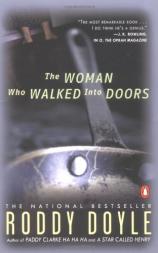Reading Group Guide
Discussion Questions
The Woman Who Walked Into Doors

1. The Woman Who Walked Into Doors
does not progress chronologically, but rather through a series of vignettes that dart back and forth in time. How does the "spiral" effect drive the story forward?
2. We don't get an objective introduction to Paula Spencer until midway through the novel, when she presents us with the "facts" of her life. Why does Doyle wait so long to give us information? How does the delay affect the novel and your view of Paula?
3. Paula replays scenes from her childhood and youth over and over in her head. Why do you think she does this? What is the function of memory in this novel?
4. What roles do fantasy and denial play in the novel? Is there a difference between Paula's romantic fantasies and her denial of family history? Is Paula doing herself any harm by not facing the truth, as Carmel would have her believe?
5. One of the most compelling scenes in the novel takes place when Paula goes searching for the key to the liquor cabinet. What makes this scene so riveting? How does Doyle convey an alcoholic's desperation?
6. What makes Paula visit the Fleming estate—the scene of Charlo's crime—and why does she mentally re-create the events that took place there?
7. "I keep blaming myself," says Paula. "After all the years and the broken bones and teeth and torture I still keep blaming myself. I can't help it. What if? What if?" Why does Paula blame herself? Does this make her more, or less, of a victim? How so?
8. Paula describes the dating scene when she was an adolescent as a cat-and-mouse game in which girls and boys became involved with each other without getting to know one another; without, in fact, both of them knowing they are involved. How does Doyle set up the story of Paula's marriage with this explanation? How do Paula's other adolescent and early experiences come into play in her later life?
9. How do Paula's and Charlo's families interfere with and dictate the marriage they will have? Paula admits the relief she felt giving up her last name for Charlo's. Do you think Paula would have been happier not marrying Charlo?
10. Paula repeatedly makes the comment that people "do not see her." What does she mean by this? How does this observation make you understand her actions and inaction?
11. In the novel's opening scene, Paula is informed of her husband's death by a young policeman. They have what appears to be a very casual conversation, and in fact, Paula doesn't find out how her husband died until much later. What does this tell you about Paula?
12. Paula finds herself forgiving Charlo: "He couldn't drive.... The poor eejit, he never got round to it. The kidnapper who couldn't drive." Do you feel any sympathy for Charlo? Do you think Doyle wants the reader to forgive him?
13. Paula finds solace in her children, yet she admits to occasionally striking them and neglecting them when she is drunk. Do you think that she is a good parent? The best parent she can be under the circumstances?
14. The novel ends with a hopeful scene which chronologically belongs somewhere in the middle of the story. Yet defeat and resignation are pervasive themes in the novel. Do you get the sense that Paula will triumph over her alcoholism? Do you think she'll find happiness in her life?
15. Roddy Doyle's first two novels, The Commitments and The Snapper, were made into critically acclaimed films, and the movie version of The Van will soon be completed. It is therefore interesting that the plot of The Woman Who Walked Into Doors originated in a teleplay about a troubled Irish family. What is it about certain novels that makes them great movies? What is it about Roddy Doyle's writing that adapts so well to the screen? Can you recognize dramatic elements in this novel that might have served Doyle in transforming spoken dialogue into written narrative?
The Woman Who Walked Into Doors
- Publication Date: January 1, 1997
- Paperback: 240 pages
- Publisher: Penguin (Non-Classics)
- ISBN-10: 0140255125
- ISBN-13: 9780140255126








